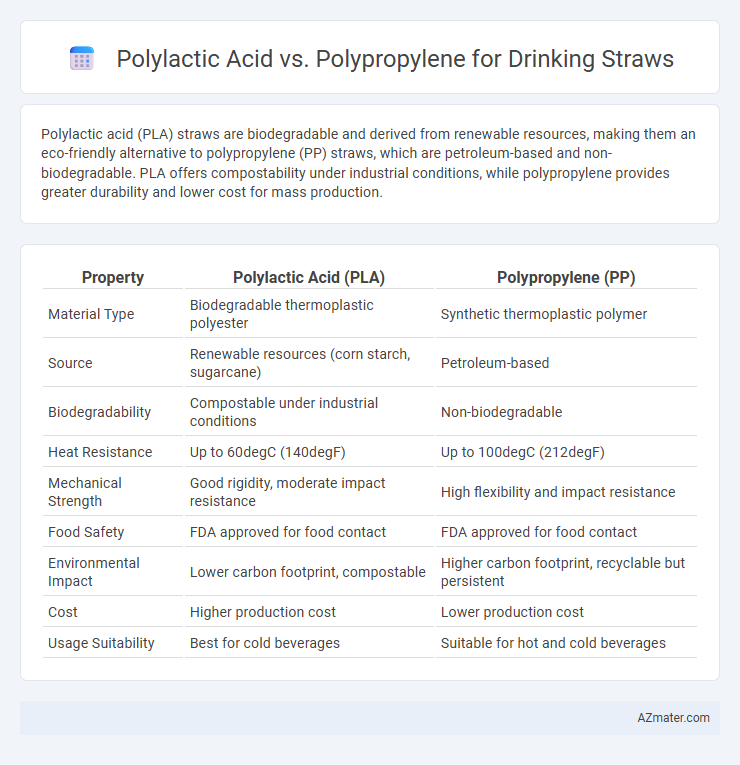Polylactic acid (PLA) straws are biodegradable and derived from renewable resources, making them an eco-friendly alternative to polypropylene (PP) straws, which are petroleum-based and non-biodegradable. PLA offers compostability under industrial conditions, while polypropylene provides greater durability and lower cost for mass production.
Table of Comparison
| Property | Polylactic Acid (PLA) | Polypropylene (PP) |
|---|---|---|
| Material Type | Biodegradable thermoplastic polyester | Synthetic thermoplastic polymer |
| Source | Renewable resources (corn starch, sugarcane) | Petroleum-based |
| Biodegradability | Compostable under industrial conditions | Non-biodegradable |
| Heat Resistance | Up to 60degC (140degF) | Up to 100degC (212degF) |
| Mechanical Strength | Good rigidity, moderate impact resistance | High flexibility and impact resistance |
| Food Safety | FDA approved for food contact | FDA approved for food contact |
| Environmental Impact | Lower carbon footprint, compostable | Higher carbon footprint, recyclable but persistent |
| Cost | Higher production cost | Lower production cost |
| Usage Suitability | Best for cold beverages | Suitable for hot and cold beverages |
Introduction to Biodegradable and Conventional Straws
Polylactic acid (PLA) straws represent a biodegradable alternative to conventional polypropylene (PP) straws, offering reduced environmental impact through compostability and renewable resource derivation from cornstarch or sugarcane. Polypropylene straws, widely used for their durability and low cost, contribute significantly to plastic pollution due to their resistance to degradation in natural environments. Comparing PLA and PP straws highlights the shift towards sustainable materials in single-use products, driven by growing regulatory restrictions and consumer demand for eco-friendly alternatives.
Overview of Polylactic Acid (PLA) Straws
Polylactic acid (PLA) straws are biodegradable alternatives made from renewable resources like cornstarch or sugarcane, offering a compostable option for single-use products. Unlike polypropylene straws, PLA straws break down in industrial composting facilities within 1 to 3 months, reducing plastic pollution in marine environments. Their smooth surface and clarity make PLA straws popular in foodservice, while their heat resistance supports use with cold and warm beverages without leaching harmful chemicals.
Overview of Polypropylene (PP) Straws
Polypropylene (PP) straws are widely used in the beverage industry due to their excellent chemical resistance, durability, and low cost. PP straws offer high flexibility and are resistant to moisture and most solvents, making them suitable for a range of hot and cold drinks. Their non-biodegradable nature contrasts with alternatives like polylactic acid (PLA), impacting environmental sustainability considerations in single-use straw applications.
Production Processes: PLA vs Polypropylene
Polylactic acid (PLA) is produced through the fermentation of renewable resources like corn starch or sugarcane, followed by polymerization of lactic acid, creating a biodegradable and compostable material. Polypropylene (PP), on the other hand, is derived from petroleum through a chemical polymerization process involving propylene monomers, resulting in a non-biodegradable, highly durable plastic. The production of PLA typically requires less energy and emits fewer greenhouse gases compared to polypropylene, making it a more environmentally friendly choice for drinking straws.
Environmental Impact and Biodegradability
Polylactic acid (PLA) straws offer significant environmental benefits due to their biodegradability and compostability, breaking down into natural components within months under industrial composting conditions. Polypropylene (PP) straws, in contrast, are derived from petrochemicals and can persist in the environment for hundreds of years, contributing to plastic pollution and microplastic contamination. The shift from PP to PLA straws supports waste reduction and aligns with sustainability goals, although PLA's reliance on agricultural feedstocks and its need for specific composting facilities remain important considerations.
Safety and Toxicity in Food Contact
Polylactic acid (PLA) is a biodegradable biopolymer derived from renewable resources such as corn starch, exhibiting excellent safety and low toxicity profiles for food contact applications, making it suitable for drinking straws. Polypropylene (PP), a widely used petroleum-based plastic, offers chemical resistance and durability but may pose concerns regarding potential leaching of additives or contaminants under certain conditions. Regulatory agencies like the FDA and EFSA have approved both PLA and PP for food contact materials, yet PLA's compostability and reduced environmental impact enhance its appeal for safer, sustainable straw alternatives.
Performance and Durability in Use
Polylactic acid (PLA) drinking straws offer biodegradability and compostability but typically exhibit lower heat resistance and mechanical strength compared to polypropylene (PP) straws. Polypropylene straws provide superior durability and flexibility, enduring higher temperatures and repeated use without deforming or breaking. For performance in hot beverages and long-term use, PP remains the more reliable option, while PLA is preferred for eco-friendly, single-use applications.
Cost Comparison and Market Availability
Polylactic acid (PLA) straws typically incur higher production costs than polypropylene (PP) straws due to renewable raw materials and complex manufacturing processes, resulting in retail prices that are 20-30% greater. Polypropylene straws dominate market availability with widespread distribution in foodservice and convenience stores, supported by efficient mass production and lower material expenses. PLA straws face limited market penetration primarily in eco-conscious sectors and specialty retailers, where demand for compostable and biodegradable alternatives is growing but remains niche compared to polypropylene.
Consumer Perceptions and Trends
Polylactic acid (PLA) drinking straws are increasingly favored by eco-conscious consumers due to their biodegradable and compostable properties, aligning with growing environmental awareness and sustainability trends. Polypropylene (PP) straws remain popular for their durability, cost-effectiveness, and ease of production but face criticism for contributing to plastic pollution, influencing a gradual consumer shift towards greener alternatives. Market data indicates a rising preference for PLA straws in foodservice sectors, driven by regulations banning single-use plastics and positive consumer perceptions of bioplastics as a healthier environmental choice.
Future Outlook: The Evolution of Drinking Straw Materials
Polylactic acid (PLA) is gaining momentum as a biodegradable alternative to polypropylene (PP) in drinking straws, driven by increasing environmental regulations and consumer demand for sustainable products. Advances in PLA production are reducing costs and improving heat resistance, making it more competitive with polypropylene's durability and flexibility. The future of drinking straw materials is likely to see a shift towards bioplastics like PLA, supported by innovation in compostability and circular economy practices.

Infographic: Polylactic acid vs Polypropylene for Drinking Straw
 azmater.com
azmater.com